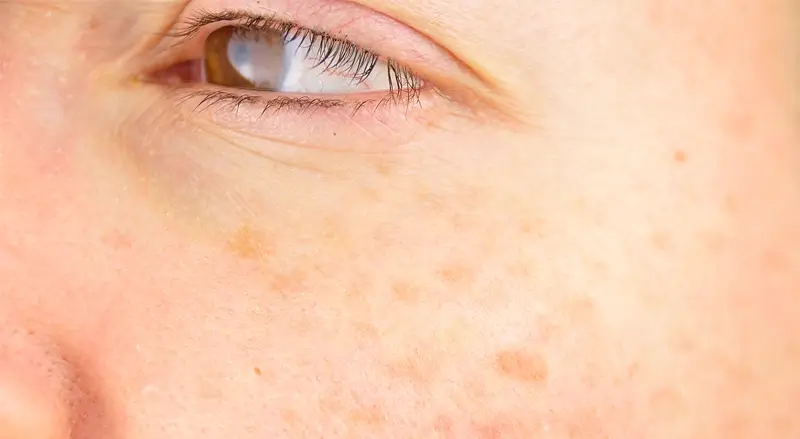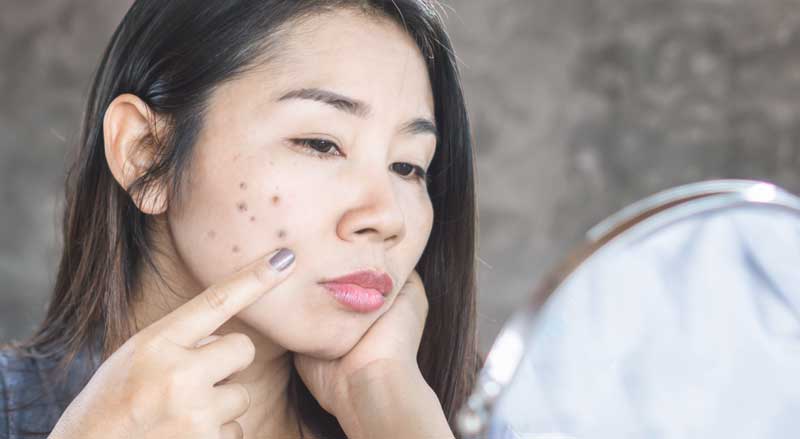How To Get Rid of Dark Spots on Your Face
Posted on |

Dark spots on your skin detract from your skin’s natural radiance. While they are a common and usually harmless skin concern, they can still cause a person to frown when they look in the mirror.
Brown patches or hyperpigmentation are terms commonly used to describe dark marks on the skin. Hyperpigmentation is when there are areas of skin that are darker than the surrounding skin.
Here’s some helpful information on how to get rid of dark spots on your face.
What Are Dark Spots and What do They Look Like
Hyperpigmentation, the usual cause of dark spots, occurs when certain cells produce too much melanin. Melanin is the pigment that’s responsible for eye, hair, and skin pigmentation.
People of all ages and skin colors can develop dark spots.
When lower layers of the skin are exposed to UVA radiation, melanocytes, which are cells, get triggered and produce melanin. The melanin protects the skin from sun damage. It also results in skin tanning.
When your skin creates a lot of melanin in smaller areas, patches of dark skin develop. These dark patches are commonly called:
- Dark spots
- Sun spots
- Age spots
- Liver Spots
These patches of discoloration can appear to be brown, black, or yellow. Their size can range from a few millimeters (which is quite tiny) to several centimeters (well over an inch) in diameter.
Age spots don’t need any medical care. However, if you have a spot that is black or has changed its appearance, see a dermatologist to rule out a diagnosis of melanoma—a skin cancer that requires immediate treatment. Be wary of spots that have changing borders or diameters, get lighter or darker, or become asymmetric.
Common Causes of Dark Spots
Dark spots commonly appear on the face, hands, arms, shoulders, chest, and back.
Sun Exposure
The skin on the face is susceptible to developing dark patches since it’s relatively delicate and has frequent exposure to the sun.
Hands also have thinner skin and greater sun exposure, so they too are a common place for dark spots to develop.
Hormonal Changes
Fluctuating hormones can cause areas of hyperpigmentation on the forehead, cheeks, upper lip, nose, and chin. This condition, called melasma, often occurs during pregnancy, during menopause, or when a woman takes birth control pills.
Hyperpigmentation often fades after pregnancy or after stopping taking birth control pills.
Age
As our skin ages, it becomes less particular about the way it distributes melanin. As a result, increased pigmentation occurs more frequently.
Inflammation and skin irritation

Acne, skin trauma and insect bites can all cause skin irritation. Any of these factors can cause overproduction of melanin. Psoriasis and eczema are two skin conditions that cause inflammation, damage skin cells, and increase melanin production as well.
Genetics
If your family has a history of hyperpigmentation, you are more likely to develop dark spots—regardless of avoidance of other common hyperpigmentation triggers.
Ethnicity
Darker skin tones are more likely to develop dark spots.
Diabetes
Diabetes is a common cause when small blood vessels become damaged and cause an increase in pigmentation.
How To Get Rid of Dark Spots

If you want to get rid of the dark spots on your face, there are several effective treatments available, including laser therapy, microdermabrasion, and chemical peels.
At Vibrance Medspa, we offer laser therapy and facial treatments which are particularly helpful in reducing bothersome areas of uneven skin tone and pigmentation.
Laser Therapy
Laser therapy safely destroys the melanin cells that cause hyperpigmentation.
Our triniti™ series of treatments includes skin rejuvenation, skin resurfacing, and skin tightening. These treatments improve uneven skin tone and pigmentation. Your skin is tightened, refreshed, and younger-looking.
We also offer Sublative Rejuvenation. This FDA-cleared fractional ablative skin resurfacing treatment treats red and brown spots, improves acne scarring, improves textural irregularities and moderate wrinkles, and much more. You enjoy more youthful and smoother skin.
Facial Treatments for Dark Spots
Our non-invasive HydraFacial MD™ treatments include hydradermabrasion, a chemical peel, painless extractions, and delivery of antioxidants, hyaluronic acid, and peptides. A Britenol™ boost effectively minimizes the appearance of dark spots and sun damaged skin and reveals a more even skin tone. Your skin glows!
Vibradermabrasion is a crystal-free dermabrasion treatment. It is helpful for sun damaged aging skin and skin with pigmentation problems.
Vi Peel reduces age spots, melasma, and freckles as it improves the texture, tone, and clarity of the skin.
Read about which chemical peel is right for you.
Home Remedies
It’s important to use home remedies for dark spots cautiously—they can cause skin irritation and may not be effective. Be sure to conduct a patch test first to avoid potential problems.
Home remedies include the direct application of these natural items:
- Aloe vera
- Lemon juice
- Milk and yogurt
- Green tea extract
- Apple cider vinegar
Try following these beauty habits for healthy glowing skin.
Cosmetics and Over-the-Counter Creams
There are many over-the-counter creams and cosmetics that claim to fade dark spots. Speak to a skin care specialist or dermatologist first for recommendations, and to determine which products will work best for you.
Vibrance Medspa offers Iamge® Ageless products that can help with pigment correction. Ask one of our medical aestheticians which product is right for you.
How To Prevent Dark Spots

An ounce of prevention is worth a pound of cure. Help keep dark spots from developing in the first place by:
- Using a sunscreen with SPF 30 or higher and cosmetics that protect your skin from the sun
- Staying out of the sun during peak sun exposure hours
- Wearing a broad-brimmed hat or baseball cap for extra protection of your face and neck
- Staying away from tanning beds
- Avoiding smoking to protect the collagen in your skin, which can minimize dark spots
Here’s more about the foundations of a healthy skincare routine.
Contact us at Vibrance Medspa for a complimentary consultation.
